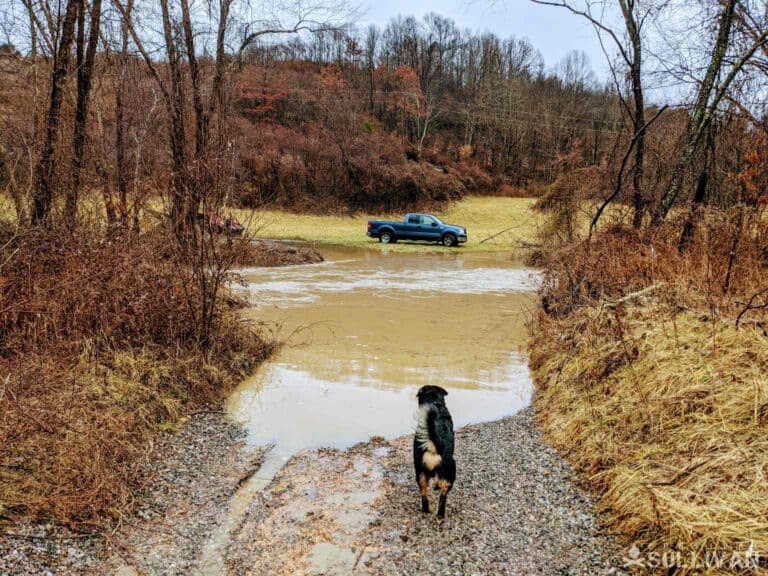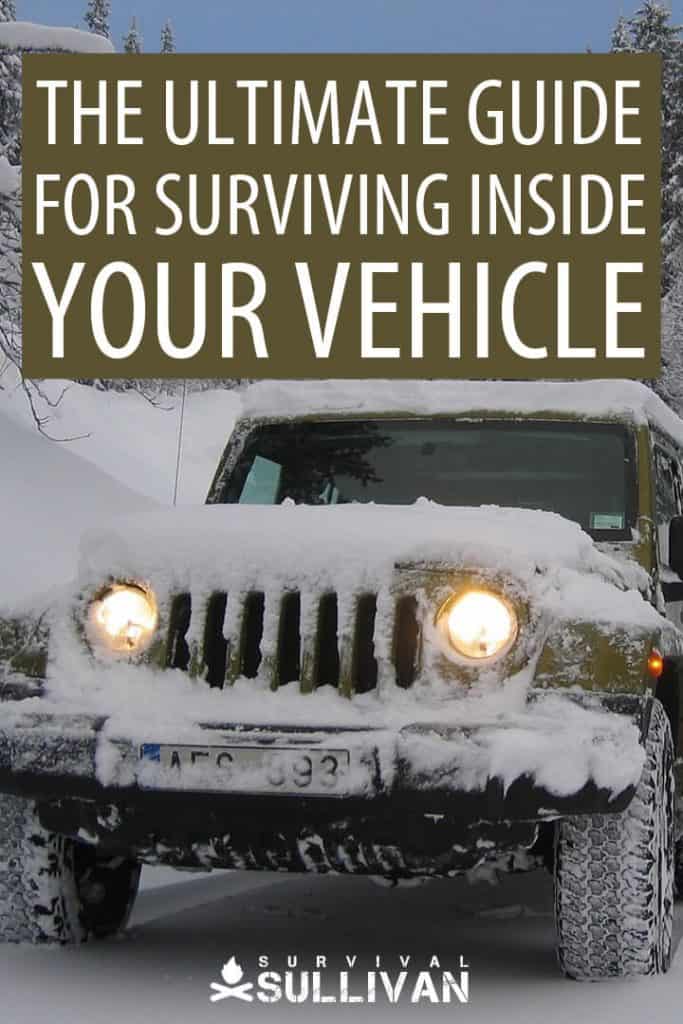We talked a lot about choosing the best bug out vehicle as well as equipping it for emergencies. But, with 55,000 Americans dying each year in car crashes, it’s critical taht we leave Doomsday aside for a moment and address personal emergencies while driving.
First off, I highly recommend you start packing your vehicle with the right items necessary to survive emergencies big and small. We have a list of over 70 items right here. You may also be interested in “bulletproofing” your car (we covered that here).

Now that we got that out of the way, let’s see all the things that can go wrong and how to actually survive various disaster scenarios inside your vehicle.
Table of Contents
Survive a Vehicle Collision – Defensive Driving
Just like a fight, the best way to avoid a car accident is to not be in one. Unfortunately, there is really no way to guarantee that you won’t be in an accident.
Even if you drive perfectly every single time, there is no way for you to control the behaviors of other drivers on the road or the unpredictable weather conditions and events delivered by Mother Nature.
Avoid Distractions
Everyone by now knows that driving while under the influence should be avoided because it makes it much more likely that you will hurt or kill yourself, your passengers, or other drivers.
In addition, the penalties for driving while intoxicated or under the influence of illegal substances are much harsher than they were even ten years ago.
Thanks to the progress of technology, we can now add no texting while driving to the list of things to avoid if you want to survive a car accident. Studies have proven that even the most experienced drivers are distracted from the road when texting or even while talking on the phone.
Proper Seated Position and Seat Belt
We’ve all seen people who drive with their seat reclined so far back you wonder if they can even see the road over the steering wheel. And we’ve probably all been a passenger on a long car ride, where the passenger kicked off their shoes and propped them up on the dashboard or even out the window so they could relax.
While this may make the ride more comfortable, sitting improperly can actually cause more serious injury and even death.
The back of your seat should be upright, with your back against it and the headrest should be in a position where it will limit movement of your head in a collision. Your seat should be positioned so that you can press down fully on the brake pedal without having to stretch your leg out completely.
Through the top part of the steering wheel you should be able to see the speedometer. Sitting incorrectly can cause injury and even death because your air bag and seat belt are designed to restrain an adult in the proper seated position.
Wear your seat belt across the chest and shoulder, not behind you or under your arm. The lap belt needs to fit snugly low and across your hips not your stomach. Wearing a seat belt incorrectly might be more comfortable while you’re driving but it can be deadly during a vehicle collision.
Learn more about surviving car crashes here.
Driving Off a Bridge
At the end of May in 2013, a semi-truck sideswiped part of the I-5 bridge, in Mount Vernon, Washington, and it collapsed. The unexpected collapse occurred over the Skagit River, and although the two vehicles crashed into the river, the scaffolding of the bridge kept the vehicles from sinking.
But about 400 people annually die as a result of drowning inside their vehicles according to the National Highway and Transportation Administration.
You can survive your car accidentally driving off of a bridge, if you are prepared and don’t panic. The most important thing is to do what you can to remain conscious, and that means wear your seatbelt at all times.
The single most important factor to surviving a submerged vehicle is the ability to escape from the car before you drown. So how do you prepare for this?
As soon as you realize that your car is going off the bridge or has gone off the bridge, roll down the windows, preferably before the car hits the water. Once the car hits the water, the floating period is somewhere between thirty seconds and one minute.
The water will also short circuit your window controls within five to 10 minutes or less. Even if the circuitry works, it will be nearly impossible to roll your window down because of the water pressure against the window frame.
Your EDC kit and/or your keychain should include something to cut your seat belt if it’s jammed as well as something to break that window.
I gave every adult member in my family one like this for Christmas last year. In most cases, your keys remain in the ignition during a crash and so it is within reach rather than thrown around the vehicle.
Have oldest children unbuckle and get them out the window first, you may have to push them out because of the water pressure. Then unbuckle younger children and either hand them out to older children or carry them with you through the window.
If the car submerges before you get the windows down, an air bubble typically forms at the back of the vehicle, move to the back and continue to try to get the window down or break it.
Once the car is completely submerged, the inner and outer pressure will equal out and it will be possible though not easy to get the door open.
Unpredictable Mother Nature
Tornado
If you’re driving in your car and you get an alert over the radio of a tornado in the area, seek cover immediately. It’s never a good idea to try to drive out of a tornado.
Even a weak tornado can shove your moving car off the road and a stronger one can certainly swoop your car right up into the air. Look for the closest structure and get inside onto the lowest level if possible. Driving under a bridge or underpass is NOT safe as the strength of the winds can actually be worse.
If there are no buildings nearby, stop the car and get quickly to the lowest lying area of the ground and lay as flat as possible with your arms over your head.
A ditch is a great option if one is available. Avoid areas with lots of trees. Do not take cover under your car as it can crush you if other debris lands on it.
The only time it’s safer to remain in your car is if the road is actually the lowest part of the area. In this case, stay in your seatbelt but get down below the windows and cover your head.
Stay under cover until the winds have ceased and all debris has stopped flying around for a consistent period of time. Keep in mind the eye of the tornado will be calmer, make sure the tornado has left the area before coming out.
Hail Storm
If you happen to be driving when a hail storm begins, the safest thing to do is to pull off the road and stop. Roads my become slick and even small hail can cause injury if winds are strong.
If possible, park in the shadow of a building or under a gas station awning that can block the worst of the hail. Do not get out of your car if hail is larger unless you are certain you can get inside a building.
Lay flat on the seat or if hail is large, get down to the floor and protect your head using a blanket or coat as a shield from glass if the windows break.
Thunderstorm
The dangers of thunderstorms if you are in your car, is flooding and lightening. Contrary to popular belief, your car is not 100% protected from lightening because of the rubber tires.
Avoid using your cell phone during a thunderstorm, especially if lightening is also occurring. The electrical systems in your car, including your GPS device, steering wheel and pedals can be affected.
So if you are caught driving in a thunderstorm and a safe building is not nearby, pull to the shoulder of the road and stop. The best thing to do is to simply fold your hands in your lap and remove your feet from the pedals. Turn the engine off and hazards on if you feel it’s safe to do so. Ensure you are not touching anything metal, including door handles.
Dust Storm
If you are driving and see a dust storm approaching, you can either try to outrun it or pull off the road and wait out the storm. Dust storms can reach speeds up to 75 mph but many times they move slower than that so it is possible to outrun a dust storm in your car.
You must weigh the risk of driving at high speeds in low visibility to get to safety versus pulling over and waiting the storm out. If you continue driving, turn your headlights on and honk the horn occasionally to warn other drivers.
Use the center line to guide you as you drive, but if visibility drops to less than about 300 feet, you should pull completely off the road. Turn all your headlights, signal lights, and brake lights off to prevent another car from following your lights and running off the road.
Roll up any windows and close vents that would allow outside air inside. Stay put until you are sure the storm has dissipated.
Flash Flood
The danger of flash floods is that they can occur in a matter of minutes and the rushing water can be deadly. We’ve all heard the warnings to avoid driving through water on a flooded road or bridges over swollen rivers.
Just six inches of water can be enough to either engine failure and/or loss of control of your vehicle. Most cars will float in water that is just a food deep and even trucks will be swept away in two feet of rushing water. So what do you do?
When you see flooding, turn around or back-up and try a different route. Look for routes that take you to higher ground. If your car is surrounded by water, get out and move quickly to higher ground. In the event you lose your footing and are being carried in fast moving water, point your feet downstream.
Pay attention and do what you can to avoid going under obstacles in the water. It’s better to go around or over them. If it appears the car will be submerged in water quickly, roll the windows down and be ready to exit the vehicle quickly.
Landslide
A landslide occurs when large pieces of earth, rock, or debris slide down a slope. They are typically set in motion during a storm, fire, earthquake, or volcanic eruption.
Sometimes construction or other attempts by people to alter the landscape can cause an unexpected landslide. The best way to survive a landslide is to avoid being caught in one, which means being alert at all times.
When you are driving, keep your eyes open for fallen rocks, cracked or collapsed pavement, debris piles, or mud. It is possible for your car to be completely surrounded by a landslide and road embankments are especially vulnerable. Always carry an emergency radio and a map of the area so you can quickly find a safe escape route.
Winter Storm
For those who live in colder climates, winter storms can often become part of the routine. But, no matter how experienced you are at driving in winter weather, you should never take for granted that you will get safely from point A to point B.
It’s very important to be prepared for more severe weather for a longer period than you anticipate. This means always having warm gloves, warm socks, boots, and a warm winter coat and hat for every person in your vehicle. Keep your vehicle in good working condition, including radiator winterization, and always keep the tank full of fuel.
A quick run to the store can turn into several hours stranded while you wait out a blinding storm or if your car breaks down or a very wintery walk to get help. For this reason, you should always have a winter weather emergency kit in your vehicle.
The two biggest dangers with being trapped in your car during a winter storm are thirst and warmth. So the most important things to carry are plenty of bottled water as well as plenty of blankets, hand warmers, and extra winter accessories (hat, gloves, wool socks, and boots).
Carry tools to get your car unstuck and/or signal for help if you slide off the road. These can include cat litter, sand, or fine gravel for traction as well as a shovel, emergency flares, and an emergency radio.
Add items such as newspapers and duct tape to insulate car windows and trap heat inside. This will greatly reduce the length of time you have to run the car heater and will stretch your fuel in case you are stranded overnight or longer.
Although the average human can go up to 3 weeks without food, you will want to have some non-perishable snacks on hand to boost your energy and morale.
Wildfire
If you are caught in a wild fire while driving in your car, it will offer no protection from the extreme heat so you should only remain in your car if there is no other viable option. Drive to the closest safe building and seek shelter inside.
If you must remain in your vehicle during a wild fire, roll up the windows and close the air vents to keep as much of the smoke out as possible. Set the air conditioning to re-circulate only.
Continue driving ahead of the fire with your lights and hazards on to alert other drivers. Be alert for people and animals that may run in front of you as they flee the fire. Continue driving away from the fire for as long as possible. Avoid turning the car engine off even if you have to stop.
If you do have to stop, try to pull over beside a building so that it can shield your car from the lethal radiant heat of the fire. If no building is nearby, stop away from any trees or other flammable objects.
Windows may shatter from the heat so lay down on the seat or floor and cover yourself with a non-synthetic coat or blanket to protect from flying glass. Drink water if you have it and use a small amount to soak a bandana or other cloth that you can breathe through to filter the smoke.
Overnight Bug Out
One of the reasons you may be stranded in your car overnight would be while traveling to your bug out location. Even if your bug out location is close and you have chosen a one of the best bug out vehicles possible, never assume that you can get there without incident.
Plan for delays, including traffic jams, vehicle malfunction, or blocked roads that mean you could be forced to the night or several nights in your vehicle.
During a bug out situation, it’s not about just surviving the night in your car, you have to be wary of being discovered by anyone more desperate than you are, who may want to try and take your vehicle and supplies.
In addition to your bug out bag essential supplies and your car bug out bag, make sure you are prepared to defend yourself with both lethal and non-lethal methods.
In addition, you will need to be smart about where you park and how you conduct yourself so that you avoid being discovered. It’s always better to keep moving if possible, but if you must stop to rest or sleep, try to park in location where you can go unnoticed.
Plan ahead to use blackout curtains or cover your windows with blankets to block out any light from your lantern or flashlight. Fire and cooking should be avoided if possible. If you must start a fire or cook, make sure you use a stealth fire to minimize risk of detection:
As you can see, with proper planning your vehicle can provide shelter for you in many of the most extreme situations. The key to surviving inside your vehicle is to know in advance how to respond to each type of situation, carry the proper supplies and equipment to fortify your vehicle, don’t panic, and take action quickly to protect yourself from harm.
Have you ever been stranded in your vehicle? Tell us about it in the comments below.


Born and raised in NE Ohio, with early memories that include grandpa teaching her to bait a hook and watching her mom, aunts, and grandmothers garden, sew, and can food, Megan is a true farm girl at heart.
For Megan, the 2003 blackout, the events of 911, and the increasing frequency of natural disasters like Hurricane Katrina, spurred a desire to be more prepared. Soon to be living off-grid, this mother of four and grandmother of ten is learning everything she can about preparedness, survival, and homesteading.

Why is there nothing for having a vehicle emergency in the dessert? On long lonely roads, etc.